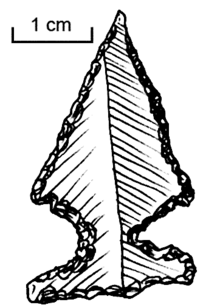Khiamian
 |
|
| Geographical range | Fertile Crescent |
|---|---|
| Period | Neolithic |
| Dates | c. 10200 – c. 8800 BCE |
| Type site | El Khiam |
| Major sites | Azraq, Abu Madi, Mureybet |
| Preceded by | Natufian culture |
| Followed by | Pre-Pottery Neolithic A |
| The Mesolithic The Epipaleolithic |
|---|
| ↑ Paleolithic |
|
| ↓ Neolithic ↓ Stone Age |
The Khiamian (also referred to as El Khiam or El-Khiam) is a period of the Near-Eastern Neolithic, marking the transition between the Natufian and the Pre-Pottery Neolithic A. Some sources date it from about 10,000 to 9,500 BCE. It currently dates between 10,200 and 8800 BC according to the ASPRO chronology.
The Khiamian owes its name to the site of El Khiam, situated on banks of the Dead Sea, where researchers have recovered the oldest chert arrows heads, with lateral notchs, the so-called "El Khiam points". They have served to identify sites of this period, which are found in Israel, as well as in Jordan (Azraq), Sinai (Abu Madi), and to the north as far as the Middle Euphrates (Mureybet).
Aside from the appearance of El Khiam arrow heads, the Khiamian is placed in the continuity of the Natufian, without any major technical innovations. However, for the first time houses were built on the ground level itself, and not half below ground as was previously done. Otherwise, the bearers of the El Khiam culture were still hunter-gatherers, and agriculture at that time was then still rather primitive, based on what has been reported on sites of this period. Newer discoveries show that in the Middle East and Anatolia some experiments with agriculture were being made by 10,900 BC. and that there may already have been experimenting with wild grain processing by around 19,000 BC at Ohalo II.
The Khiamien also sees a change occur in the symbolic aspects of culture, as evidenced by the appearance of small female statuettes, as well as by the burying of aurochs skulls. According to Jacques Cauvin, it is the beginning of the worship of the Woman and the Bull, as evidenced in the following periods of the Near-Eastern Neolithic.
...
Wikipedia
